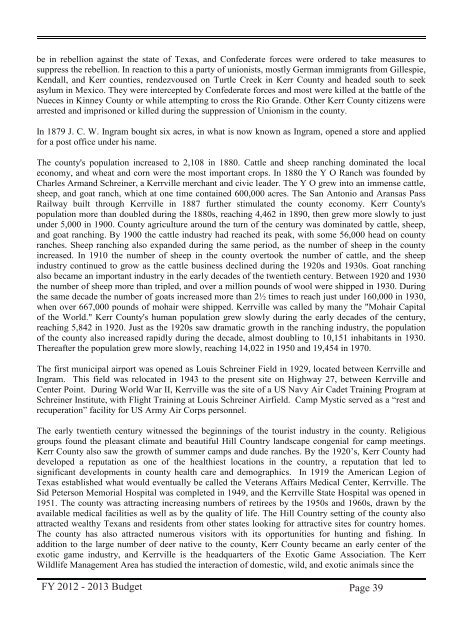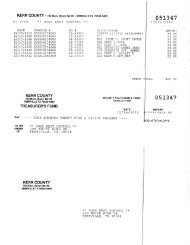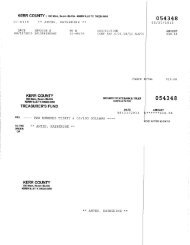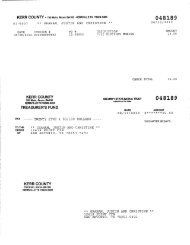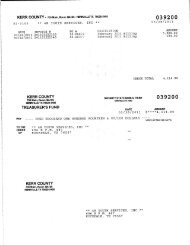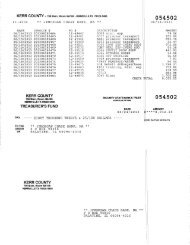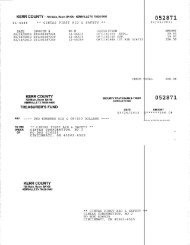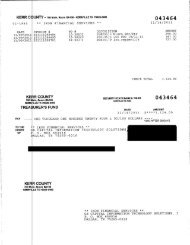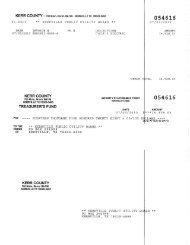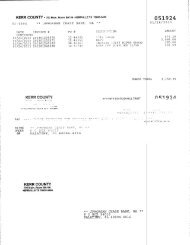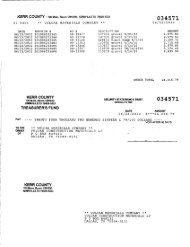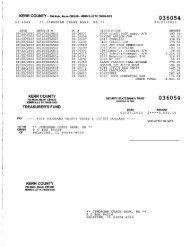Adopted Budget FY 2012-2013 - Kerr County
Adopted Budget FY 2012-2013 - Kerr County
Adopted Budget FY 2012-2013 - Kerr County
Create successful ePaper yourself
Turn your PDF publications into a flip-book with our unique Google optimized e-Paper software.
e in rebellion against the state of Texas, and Confederate forces were ordered to take measures to<br />
suppress the rebellion. In reaction to this a party of unionists, mostly German immigrants from Gillespie,<br />
Kendall, and <strong>Kerr</strong> counties, rendezvoused on Turtle Creek in <strong>Kerr</strong> <strong>County</strong> and headed south to seek<br />
asylum in Mexico. They were intercepted by Confederate forces and most were killed at the battle of the<br />
Nueces in Kinney <strong>County</strong> or while attempting to cross the Rio Grande. Other <strong>Kerr</strong> <strong>County</strong> citizens were<br />
arrested and imprisoned or killed during the suppression of Unionism in the county.<br />
In 1879 J. C. W. Ingram bought six acres, in what is now known as Ingram, opened a store and applied<br />
for a post office under his name.<br />
The county's population increased to 2,108 in 1880. Cattle and sheep ranching dominated the local<br />
economy, and wheat and corn were the most important crops. In 1880 the Y O Ranch was founded by<br />
Charles Armand Schreiner, a <strong>Kerr</strong>ville merchant and civic leader. The Y O grew into an immense cattle,<br />
sheep, and goat ranch, which at one time contained 600,000 acres. The San Antonio and Aransas Pass<br />
Railway built through <strong>Kerr</strong>ville in 1887 further stimulated the county economy. <strong>Kerr</strong> <strong>County</strong>'s<br />
population more than doubled during the 1880s, reaching 4,462 in 1890, then grew more slowly to just<br />
under 5,000 in 1900. <strong>County</strong> agriculture around the turn of the century was dominated by cattle, sheep,<br />
and goat ranching. By 1900 the cattle industry had reached its peak, with some 56,000 head on county<br />
ranches. Sheep ranching also expanded during the same period, as the number of sheep in the county<br />
increased. In 1910 the number of sheep in the county overtook the number of cattle, and the sheep<br />
industry continued to grow as the cattle business declined during the 1920s and 1930s. Goat ranching<br />
also became an important industry in the early decades of the twentieth century. Between 1920 and 1930<br />
the number of sheep more than tripled, and over a million pounds of wool were shipped in 1930. During<br />
the same decade the number of goats increased more than 2½ times to reach just under 160,000 in 1930,<br />
when over 667,000 pounds of mohair were shipped. <strong>Kerr</strong>ville was called by many the "Mohair Capital<br />
of the World." <strong>Kerr</strong> <strong>County</strong>'s human population grew slowly during the early decades of the century,<br />
reaching 5,842 in 1920. Just as the 1920s saw dramatic growth in the ranching industry, the population<br />
of the county also increased rapidly during the decade, almost doubling to 10,151 inhabitants in 1930.<br />
Thereafter the population grew more slowly, reaching 14,022 in 1950 and 19,454 in 1970.<br />
The first municipal airport was opened as Louis Schreiner Field in 1929, located between <strong>Kerr</strong>ville and<br />
Ingram. This field was relocated in 1943 to the present site on Highway 27, between <strong>Kerr</strong>ville and<br />
Center Point. During World War II, <strong>Kerr</strong>ville was the site of a US Navy Air Cadet Training Program at<br />
Schreiner Institute, with Flight Training at Louis Schreiner Airfield. Camp Mystic served as a “rest and<br />
recuperation” facility for US Army Air Corps personnel.<br />
The early twentieth century witnessed the beginnings of the tourist industry in the county. Religious<br />
groups found the pleasant climate and beautiful Hill Country landscape congenial for camp meetings.<br />
<strong>Kerr</strong> <strong>County</strong> also saw the growth of summer camps and dude ranches. By the 1920’s, <strong>Kerr</strong> <strong>County</strong> had<br />
developed a reputation as one of the healthiest locations in the country, a reputation that led to<br />
significant developments in county health care and demographics. In 1919 the American Legion of<br />
Texas established what would eventually be called the Veterans Affairs Medical Center, <strong>Kerr</strong>ville. The<br />
Sid Peterson Memorial Hospital was completed in 1949, and the <strong>Kerr</strong>ville State Hospital was opened in<br />
1951. The county was attracting increasing numbers of retirees by the 1950s and 1960s, drawn by the<br />
available medical facilities as well as by the quality of life. The Hill Country setting of the county also<br />
attracted wealthy Texans and residents from other states looking for attractive sites for country homes.<br />
The county has also attracted numerous visitors with its opportunities for hunting and fishing. In<br />
addition to the large number of deer native to the county, <strong>Kerr</strong> <strong>County</strong> became an early center of the<br />
exotic game industry, and <strong>Kerr</strong>ville is the headquarters of the Exotic Game Association. The <strong>Kerr</strong><br />
Wildlife Management Area has studied the interaction of domestic, wild, and exotic animals since the<br />
<strong>FY</strong> <strong>2012</strong> - <strong>2013</strong> <strong>Budget</strong><br />
Page 39


